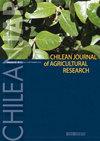Effect of soil tillage and nitrogen fertilizer management on methane emissions from irrigated rice fields in Central Java, Indonesia
IF 1.7
4区 农林科学
Q2 Agricultural and Biological Sciences
引用次数: 0
Abstract
Rice ( Oryza sativa L.) production in the future aims to increase productivity every year with high input technology, including irrigated rice. However, the practices of irrigated rice fields have a high methane (CH 4 ) production potential. Soil tillage could affect CH 4 emission conditions. Puddling and flooding through soil tillage create reduction conditions that promote CH 4 production by methanogenic bacteria. The objective was to determine the effect of soil tillage and N fertilizer management on CH 4 emissions from rice fields with heavy-textured soil. The field experiment was arranged in a split-plot design in which soil tillage was the main plot and consisted of maximum tillage and no-tillage. Nitrogen fertilizer management was the split plot and consisted of a control without N, prilled urea broadcasting, prilled urea deep placement, ammonium sulfate (AS) broadcasting, AS deep placement, and tablet urea deep placement. No-tillage could reduce CH 4 emissions by 15.58% compared with maximum tillage. However, grain yield for no-tillage was lower than for maximum tillage with 2.73 and 3.68 t ha -1 , respectively. The AS and tablet urea deep placement emitted lower CH 4 and grain yield was higher than with other N management practices. The CH 4 emissions for AS and tablet urea deep placement was 96 and 97 kg CH 4 ha -1 season -1 and grain yield was 3.79 and 4.25 t ha -1 , respectively. The application of fertilizers incorporated into the soil increased rice productivity and mitigated CH 4 emissions from rice fields.土壤耕作和氮肥管理对印尼中爪哇灌溉稻田甲烷排放的影响
未来的水稻生产旨在通过包括灌溉水稻在内的高投入技术每年提高生产力。然而,灌溉稻田的做法具有很高的甲烷(CH4)生产潜力。土壤耕作可能影响CH4的排放条件。通过土壤耕作进行的施肥和淹水创造了减少甲烷细菌产生CH4的条件。目的是确定土壤耕作和氮肥管理对重质地土壤稻田CH4排放的影响。田间试验采用分块设计,以土壤耕作为主,包括最大限度耕作和免耕。氮肥管理是一个分块区,由不施氮的对照、尿素撒播、尿素深层撒播、硫酸铵(AS)撒播、AS深层撒播和尿素片深层撒播组成。与免耕相比,免耕可减少15.58%的CH4排放。然而,免耕的粮食产量低于免耕,分别为2.73和3.68t ha-1。与其他氮管理措施相比,施用AS和片剂尿素深层处理释放的CH4较低,籽粒产量较高。AS和片剂尿素深埋的CH4排放量分别为96和97 kg CH4 ha-1季1,粮食产量分别为3.79和4.25 t ha-1。在土壤中施用化肥提高了水稻生产力,减少了稻田的CH4排放。
本文章由计算机程序翻译,如有差异,请以英文原文为准。
求助全文
约1分钟内获得全文
求助全文
来源期刊
CiteScore
3.00
自引率
11.80%
发文量
60
审稿时长
6 months
期刊介绍:
ChileanJAR publishes original Research Articles, Scientific Notes and Reviews of agriculture, multidisciplinary and agronomy: plant production, plant protection, genetic resources and biotechnology, water management, soil sciences, environment, agricultural economics, and animal production (focused in ruminant feeding). The editorial process is a double-blind peer reviewing, Editorial Office checks format, composition, and completeness, which is a requirement to continue the editorial process. Editorial Committee and Reviewers evaluate relevance and scientific merit of manuscript.

 求助内容:
求助内容: 应助结果提醒方式:
应助结果提醒方式:


